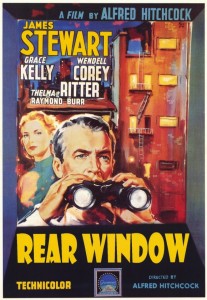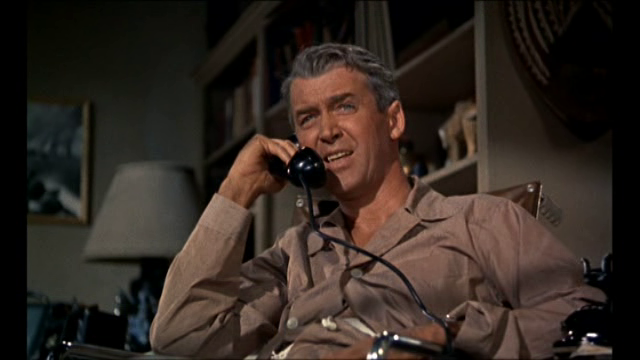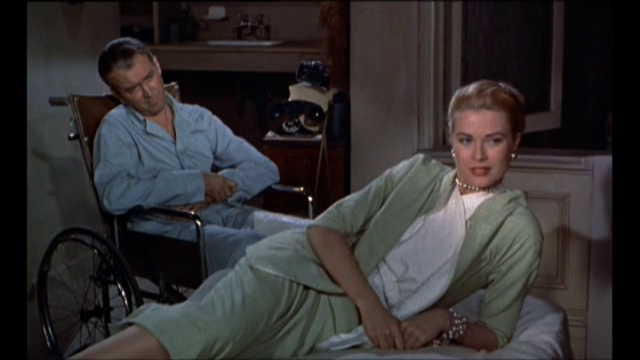Rear Window (1954)
“We’ve become a race of Peeping Toms. What people ought to do is get outside their own house and look in for a change.”
|
Synopsis: |
|
Genres, Themes, Actors, and Directors:
Response to Peary’s Review: As Peary notes, a “related and equally important theme (central to most Hitchcock films) is that even the most [seemingly] predictable people are capable of doing wildly unpredictable things” — demonstrated by the fact that “Kelly, who’s the type to fret over a broken fingernail, can be gallant enough to climb up a railing into a murderer’s apartment”. Speaking of Kelly, she’s not only as gorgeous as ever here (wearing “Edith Head’s lavish, sexy costumes”), but, as noted by Vincent Canby in his NY Times review of the film for its 1983 re-release, gives “probably her most successful performance, one in which the facts of her public personality and the fiction of the film become marvelously mixed”. We are actually able to have some fun with her notorious ice-princess persona, since it’s called out time and again by Stewart. Ultimately, Kelly’s impossible beauty and charm (could she BE any more perfect?) simply serve to heighten the fact that Stewart is scared to death of marital commitment (as wryly evidenced by his silently judgmental observations of various married couples in apartments across the way). As noted by Gary Mairs in his review of the film for Culture Vulture, “he fears domestication… and the stories he watches in his neighbors’ windows come to resemble projections of all his worst connubial fantasies”. To that end, Mairs picks up on the Peeping Tom theme once again by arguing that Stewart’s “desire to watch overwhelms his desire for [Kelly], and he only really becomes aroused when she joins him in peeping.” Speaking of such matters, Hitchcock and screenwriter John Michael Hayes get away with an astonishing amount of sexual subtext for the times — most notably in Kelly’s brazen assertion that she’ll be spending the night in Stewart’s apartment, followed by pulling out and donning a sexy negligee; as Jonathan Rosenbaum points out in his analysis of the film, “one suspects the censors were placated only because Jeff’s plaster cast made sex between him and Lisa seem unlikely.” Any discussion of Rear Window‘s multiple merits as a cinematic masterpiece would be incomplete without mentioning its sheer technical bravado. Hitchcock was clearly at the top of his game when planning and executing his vision for the film, given his consistently innovative approach to the material. Collaborating with DP Robert Burks — and given a truly impressive set to work with (possessing no less than 31 apartments!) — Hitchcock tells nearly the entire story from a camera “situated in the living room of [Stewart]… so we sense how trapped he feels while stuck in his apartment”. Until Stewart pulls out his camera’s zoom lens as makeshift binoculars, we’re restricted to the same limited view of his neighbors’ existence as he is; we’re never privy to anything more than what Stewart himself can see — which is what makes the finale so terrifying (though I won’t say more about that here, at risk of revealing spoilers). Redeeming Qualities and Moments:
Must See? Categories
(Listed in 1001 Movies You Must See Before You Die) Links: |







2 thoughts on “Rear Window (1954)”
A no-brainer must!
Certainly enough has been written about ‘Rear Window’, so I don’t need to add much more. But what can I say…?
‘RW’ is, of course, one of five Hitch films that he had the rights to and kept out of circulation for a long time. So, it’s one that I can’t recall seeing as a growing ff. When I finally did see it (I don’t know, at a revival house?, on VHS?), I remember being enthralled by it. However, no experience has been as satisfying as recently seeing the perfectly restored version (painstakingly accomplished by James Katz and Robert Harris) on DVD. The enhancement of the original color palette is simply astonishing. ‘RW’ is a film largely ruled by color sense; you could revisit it for that reason alone.
Good thing it also happens to be a masterpiece! The word ‘masterpiece’ is sometimes thrown around when it shouldn’t be. I try to be careful when I use it. I guess I feel ‘RW’ is rather perfect. Given the kind of story it is, and given how it could easily have been directed in a more pedestrian manner by someone less capable than Hitch (and still maybe be a nice little film), it’s truly stunning to see the level that Hitch raised this story to. The care that was taken is noticeable and the extent of detail is remarkable.
Actually, to me, ‘RW’ seems to be the most elegant murder mystery ever. Not so much because of its love angle, or Kelly’s character – but because that describes the whole look and feel of the film: elegant. Hard to imagine, but elegant and also tense as hell.
As for the performances, they’re all fine – and they all seem to simply serve the film rather than stand out in any way. (Here that’s a good thing.) Ritter, of course, could just about steal any film she’s in (and she does get most of the lovely laugh lines) but she’s still as controlled as the other major players. Kelly, naturally, is Kelly. Her looks don’t personally persuade me in any way but she is perfectly cast (not that it’s a terribly demanding role, all things considered). The relationship between Stewart and Kelly does, at some point, start to be bothersome in a sense. (When I see a couple in film like this, who have very little in common – or maybe they’re just realizing that? – and don’t seem to ‘spar’ all that well when talking, I end up thinking the sex must be too good to give up; what else would there be?) What changes in their relationship along the way isn’t the most believable of progressions, but it does work on a kind of fantasy level – and it’s quite a nice moment when Stewart is given reason to really want Kelly for the woman she chooses to become.
Much of the wonderful stuff to know about ‘RW’ is contained in the restored-version DVD. There’s a delightful and revealing segment with screenwriter Hayes, and an hour-long making-of doc that, admittedly, is not suspenseful but just as riveting as ‘RW’ itself (and that includes the info on the restoration process!).
Note on Judith Evelyn (Miss Lonelyhearts): the following year, Evelyn would play an all-too-similar role in the delicious camp classic, ‘Female on the Beach’ – although, luckily, ‘RW’ affords the character more of a safety net.
I’ve just read the original Woolrich short story. Good as it is (and it’s quite good), the film version is an improvement. Most of what’s in the story is in the film, though the film expands considerably (i.e., in the story, the apartment building the protagonist is watching is much smaller and there’s little activity outside the main action). Where the film especially succeeds is the climax. In the story, the conclusion is somewhat similar though it’s also somewhat abrupt. Hitch’s film, however, capitalizes for maximum effect.